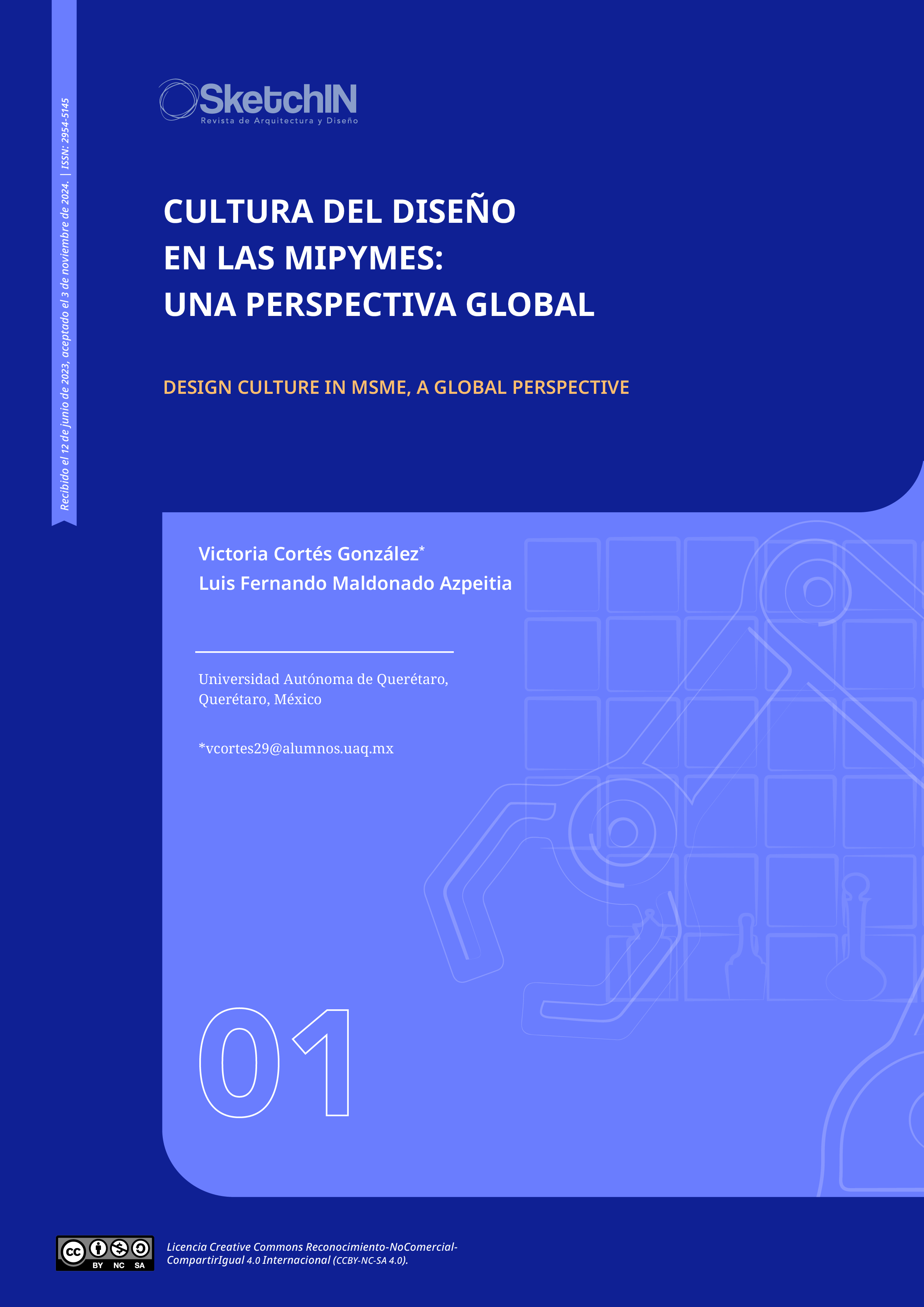Abstract
The lack of recognition of the value and integration of design in MSMEs is a problem that affects the practice of the discipline and its evolution within organizations, so efforts have been made globally to make its relevance visible and promote its incorporation into the organizational culture of companies. This article is a compilation and bibliographic analysis resulting from an exploration oriented to the value of design, the methods to measure its integration in companies and the culture of design in a framework of integration into MSMEs. A search matrix was constructed for the compilation of bibliography and subsequently the research results were analyzed and summarized. It is recognized that the practice of design within companies aggregates value to their products and services; however, integrating it into the operational flow turns out to be a challenge, since it not only requires the application of specific procedures, but a change in the cultural background as well.
References
Acklin, C. (2013). Design Management Absorption Model: A Framework to Describe and Measure the Absorption Process of Design Knowledge by SMEs with Little or no Prior Design Experience. Creativity and Innovation Management, 22(2), 147-160. DOI: 10.1111/caim.12022
Akpinar, M. y Mermercioglu, M. (2014). Utilizing Design in Facilitating Innovations at Turkish Firms. En Proceedings of the 7th Knowledge Cities World Summit, Tallinn, Estonia, 100-106. https://www.digar.ee/arhiiv/et/download/115021#page=100
Alarcón, J., Lecuona, M. y Ormeño, G. (2015). Design Management to Increase Small and Medium Multisector Enterprises (Smes) Competitiveness: Interdisciplinary Experience with Public Funding. En 7th International Conference on Education and New Learning Technologies, Barcelona, España, 3067-3075. https://library.iated.org/view/ALARCON2015DES
Briede-Westermeyer, J., Cabello Mora, M., Pacheco Blanco, B. y Cartes Sanhueza, J. (2016). Implicación de Participantes en la Fase de Diseño Conceptual de un Producto. Caso de Estudio del Impacto de la Metodología Sistémica en una PYME Chilena. Interciencia, 41(9), 622-628.
Camargo Cea, N. (2016). Una mirada a la objetividad del proceso de diseño. Arcos Design, 9(2), 110-131. DOI: 10.12957/arcosdesign.2016.19108
Carneiro, V., Barata da Rocha, A., Rangel, B. y Lino Alves, J. (2021). Design Management and the SME Product Development Process: A Bibliometric Analysis and Review. She Ji: The Journal of Design, Economics, and Innovation, 7(2), 197-222. DOI: 10.1016/j.sheji.2021.03.001
Costa, J., Martins, J., Gonçalves, R., Botelho, S., Maia, P., Mendonca, R. y Franqueira, T. (2011).
Design Research Applicability on Portuguese Industry - Recipor S.A. Company. En Proceedings of the 2011 Conference on Designing Pleasurable Products and Interfaces, Milán, Italia. DOI: 10.1145/2347504.2347552
Del Giorgio Solfa, F. y D’Amico, E. (2019). Complejidad y obstáculos del ecosistema emprendedor argentino: El lado B de un sueño emprendedor. XIII Jornadas de Sociología. Las cuestiones de la Sociología y la Sociología en cuestión, Buenos Aires, Argentina, 1-17. https://www.aacademica.org/del.giorgio.solfa/326.pdf
Design Council. (2014). Leading Business by Design: High Value Manufacturing. Londres: Design Council. https://www.designcouncil.org.uk/fileadmin/uploads/dc/Documents/Leading%2520Business%2520By%2520Design_High%2520value%2520manufacturing.pdf
Design Council. (2020). Using design as a force for change. Londres: Design Council. https://newsblogs.ihbc.org.uk/?p=30327
Elsbach, K. y Stigliani, I. (2018). Design Thinking and Organizational Culture: A Review and Framework for Future Research. Journal of Management, 44(6), 1-33. DOI: 10.1177/0149206317744252
Fonseca Braga, M. (2017). The choice of design. From businesses’ conditions to businesses’ attitudes. The Design Journal, 20(1), 635-646. DOI: 10.1080/14606925.2017.1353011
Hernández Sampieri, R., Fernández Collado, C. y Baptista Lucio, P. (2014). Metodología de la Investigación. México: McGraw-Hill Education.
Igorevna, N. (2020). Phenomenon of Design Culture in the Aspect of Specialist’s Professional and Personal Development. ЧЕЛОВЕК И ОБРАЗОВАНИЕ, 1(62), 71-75. https://cyberleninka.ru/article/n/fenomen-proektnoy-kultury-v-aspekte-professionalno-lichnostnogo-razvitiya-spetsialista
Jaramillo, H., Lugones, G. y Salazar, M. (2001). Manual de Bogotá: Normalización de Indicadores de Innovación Tecnológica en América Latina y el Caribe. OEI. https://oei.int/oficinas/argentina/publicaciones/manual-de-bogota-normalizacion-de-indicadores-de-innovacion-tecnologica-en-america-larina-y-el-caribe/
Kim, J. y Chung, K. (2012). Evaluating the Values of Design from the Economics Perspective. En Research: Uncertainty Contradiction Value - DRS International Conference 2012, Bangkok, Tailandia, 849-858. https://dl.designresearchsociety.org/drs-conference-papers/drs2012/researchpapers/63/
Landoni, P., Dell’Era, C., Ferraloro, G., Peradotto, M., Karlsson, H. y Verganti, R. (2016). Design contribution to the competitive performances of SMEs: The Role of Desing Innovation Capabilities. Creativity and Innovation Management, 25(4), 484-499. DOI: 10.1111/caim.12165
Legarda, I., Iriarte, I., Hoveskog, M. y Lozano, D. (2021). A Model for Measuring and Managing the Impact of Design on the Organization: Insights from Four Companies. Sustainability, 13(22), 1-23. DOI: 10.3390/su132212580
Maduro, S., Fernandes, P. y Alves, A. (2017). Management Design as a strategic lever to add value to Corporate Reputation competitiveness in Higher Education Institutions. Competitiveness Review, 28(1), 1-38. DOI: 10.1108/CR-04-2017-0029
Manzini, E. (2016). Design Culture and Dialogic Design. Design Issues, 32(1), 52-56. DOI: 10.1162/DESI_a_00364
Márquez Cañizares, J. y Cisneros Ortega, J. (2014). Diseño industrial en Pymes de manufactura: gestión con un modelo innato como estrategia de posicionamiento. Iconofacto, 10(14), 138-160. https://repository.upb.edu.co/handle/20.500.11912/7379
Micheli, P., Perks, H. y Beverland, M. (2017). Elevating design in the Organization. The Journal of Product Innovation Management, 35(4), 629-651. DOI: 10.1111/jpim.1243
Michlewski, K. (2015). Design Attitude. Londres: Gower Publishing.
Mortati, M., Villari, B. y Maffei, S. (2014). Design Capability for Value Creation. 19th DMI: Academic Design Management Conference, Londres, EE. UU., 2490-2512. https://www.academia.edu/117187430/Design_Capability_for_value_creation
Muratovski, G. (2015). Paradigm Shift: Report on the New Role of Design in Business and Society. SheJi: The Journal of Design, Economics, and Innovation, 1(2), 118-139. DOI: 10.1016/j.sheji.2015.11.002
Rodgers, P., Mazzarella, F. y Conerney, L. (2020). Interrogating the Value of Design Research for Change. The Design Journal, 23(4), 491-514. DOI: 10.1080/14606925.2020.1758473
Shams, M. y Lam, B. (2016). Strategic Design Versus Silent Design: A Reckoning. Design Management Review, 27(3), 28-33. DOI: 10.1111/drev.12034
Topaloğlu, F. y Er, Ö. (2017). Discussing a New Direction for Design Management through a New Design Management Audit Framework. The Design Journal, 20(1), S502-S521. DOI: 10.1080/14606925.2017.1353000
Tuncer Manzakoglu, B. y Er, Ö. (2021). Design Management Capability Assessment from the Perspective of Companies Pursuing Different Business Strategies in Global Value Chains. METU: Journal of the Faculty of Architecture, 38(2), 241-262. DOI: 10.4305/METU.JFA.2021.2.10
Wrigley, C. (2017). Principles and practices of a design-led approach to innovation. International Journal of Design Creativity and Innovation, 1-23. DOI: 10.1080/21650349.2017.1292152

This work is licensed under a Creative Commons Attribution-NonCommercial-ShareAlike 4.0 International License.
Copyright (c) 2025 SketchIN

